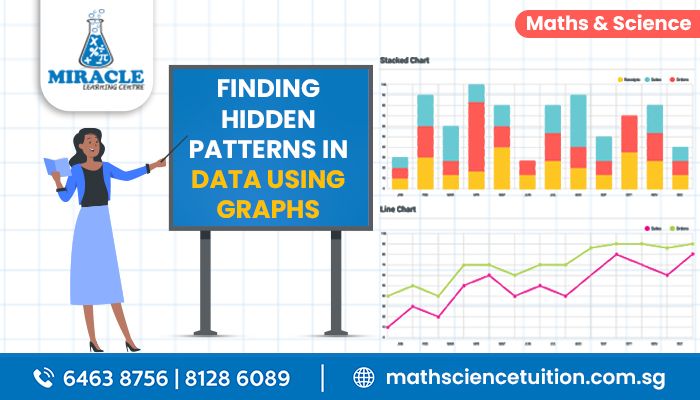Graphs are strong visual representations of relationships, patterns, and data that are frequently used in mathematics to represent and analyse them. They offer an approach to represent complex concepts visually and make it simpler to comprehend and analyse mathematical information. At our maths tuition centre, we recognize the pivotal role that graphs play in illuminating the world of mathematics. From the elegant simplicity of line graphs to the labyrinthine complexity of network diagrams, we understand the power of graphs to transcend disciplines and open up new realms of understanding. Join us as we embark on a journey through the multifaceted world of graphs, discovering their essence, exploring their various types, and grasping their profound influence in making the abstract tangible and the intricate accessible.
What is a Graph?
In mathematics, a graph serves as a dynamic visual portrayal of a set of objects, often denoted as “vertices” or “nodes,” interconnected by links called “edges.” These visual structures are employed to illustrate intricate relationships, unveil patterns, and dissect data with a clarity that textual representation often struggles to achieve. Graphs emerge as an invaluable asset across numerous mathematical branches and extend their influence well beyond the realm of numbers and equations.
Components of a Graph:
Understanding the anatomy of a graph is essential for a comprehensive grasp of its structure and purpose. Graphs consist of several fundamental components, each playing a distinct role:
- Vertices (Nodes):
These are the fundamental data points within a graph. Vertices represent individual entities, items, or data elements, serving as the building blocks of connections and relationships in the graph.
- Edges (Lines):
Edges establish connections between vertices. They depict the relationships, interactions, or associations between the data points represented by the vertices. Edges are crucial for conveying the underlying connections and patterns within the data.
- Axes:
In Cartesian graphs, axes form the reference lines that define the coordinate system. The horizontal axis (x-axis) and vertical axis (y-axis) intersect at the origin, enabling precise positioning of data points and aiding in the interpretation of the graph’s content.
- Labels and Scales:
Labels and scales provide context and measurement to the graph. They help users understand the values, units, or categories being represented along the axes. Labels describe what is being measured or depicted, while scales define the intervals and values along the axes, enabling accurate interpretation of the graph’s data.
Functions of Graphs:
Graphs play a pivotal role in portraying various mathematical functions, offering a dynamic visual representation of the intricate relationships between variables. Let’s explore some fundamental types of functions that find expression through graphs:
Identity Function: The foundational function, often denoted as f(x) = x, establishes a direct correspondence between each input value and itself on the graph. This linear relationship forms the basis for comprehending more complex functions.
Constant Function: Expressed as f(x) = c, where c is a constant value, this function generates a horizontal line on the graph. It serves as a simple yet essential tool for understanding functions with unchanging outputs.
Polynomial Function: These versatile functions involve multiple terms with various powers of x. Graphically, polynomial functions manifest as curves that exhibit distinct shapes based on the degree of the polynomial. Their graphs offer insights into the behavior of functions with multiple terms.
Rational Functions: Formed by the ratio of two polynomials, rational functions often introduce points of discontinuity and asymptotes in their graphs. Visualizing these graphs helps us comprehend where the function is defined and where it behaves erratically.
Modulus Function: Captured by f(x) = |x|, this function’s graph takes the form of a V, representing the absolute value of x. The graph highlights the positive nature of both positive and negative values, offering an intuitive visual understanding.
Signum Function: Represented as f(x) = sgn(x), this function’s graph displays distinct steps corresponding to the sign of x (positive, negative, or zero). The graphical steps mirror the decision-making process of the signum function.
Greatest Integer Function: Often denoted as f(x) = ⌊x⌋, the greatest integer function’s graph consists of step-like segments that underscore the greatest integer less than or equal to x. This function’s graph unveils the discreet nature of integer values.
Through these graphical representations of various functions, students attending our Maths tuition gain a profound appreciation for the intricate mathematical relationships that underpin our understanding of the world. Each function type, illustrated vividly at our Maths tuition Centre, offers a unique insight into the behaviour and characteristics of mathematical processes..
Types of Graphs:
Graphs come in a variety of forms, each tailored to convey specific types of information and relationships. Here are some common types:
1. Line Graphs:
These are employed to exhibit trends over time or continuous data. For instance, they are used to illustrate stock market trends and fluctuations in temperature.
2. Bar Graphs:
Designed to represent discrete data through rectangular bars, these are particularly useful for comparing different categories. Examples of their usage include displaying survey results and depicting population distribution.
3. Pie Charts:
These charts depict parts of a whole using sectors of a circle. They are often employed to convey percentage-based data, such as market shares or demographic breakdowns.
4. Scatter Plots:
Used to visualize correlations between two variables, scatter plots plot data points on a Cartesian plane. These are valuable tools for identifying relationships between variables and identifying outliers.
5. Histograms:
These graphs provide insight into the frequency distribution of continuous data. Bars in histograms touch to indicate grouped data ranges, making them especially useful for understanding data distribution.
If you’re looking to delve deeper into the world of graphs and enhance your understanding of their applications, consider exploring maths tuition opportunities at Miracle Learning Centre. We provide comprehensive courses that cover graph theory and various mathematical concepts. Through our interactive and tailored approach, you can grasp the intricacies of graphs and their significance in diverse fields, empowering you with valuable skills for academic excellence and beyond.
Applications of Graphs:
The utility of graphs transcends various fields due to their ability to simplify complex data representations. Some applications include:
Science: Graphs are extensively used in scientific research to illustrate data and analyze patterns. They are crucial in physics, biology, chemistry, and environmental science to represent experimental results and trends.
Economics: In economics, graphs help visualize supply and demand curves, market trends, and economic models. They make complex economic concepts more accessible.
Engineering: Engineers use graphs to design and analyze systems, from circuit diagrams to structural stability. Control systems, signal processing, and network design heavily rely on graphs.
Social Sciences: Graphs assist sociologists and psychologists in studying human behavior, social networks, and statistical trends.
Medicine: Medical researchers use graphs to visualize patient data, track disease outbreaks, and study treatment effectiveness.
Computer Science: Graph theory is fundamental in computer science, aiding in the design of algorithms, network analysis, and data structures.
Environmental Studies: Environmentalists use graphs to display climate data, pollution levels, and ecosystem changes over time.
Conclusion:
In the realm of mathematics and beyond, graphs stand as crucial tools for translating intricate data, relationships, and functions into visual representations. Their versatility spans numerous fields, making them indispensable for communication, analysis, and prediction. Whether you’re deciphering economic trends, visualizing scientific data, or exploring social networks, graphs provide an elegant and efficient means of understanding the complexities that surround us.
At Our Maths Tuition Centre, we recognize the pivotal role of graphs in enhancing mathematical comprehension. Through our comprehensive guidance and dedicated approach to teaching, we empower students to not only grasp the intricacies of graphs but also apply them effectively across various domains. At Miracle Learning Centre with Our Maths Tuition programs, students gain not only proficiency in graph interpretation but also the confidence to excel in the broader mathematical landscape.


